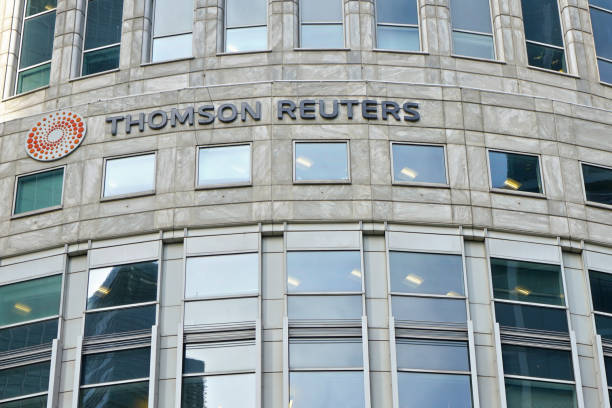Do you want to protect your business from the costly effects of financial crime?
Then join us as we explore Thomson Reuters’ collaboration with Salesforce, helping customers step up their fight against financial crime. By understanding their advanced technologies, you can gain the edge to stay safe in this ever-evolving threat landscape.
Introduction: The Future of Financial Crime Prevention
Financial crime prevention continues to evolve as threats of financial fraud, money laundering and terrorist financing increase globally. With new technologies, business models and compliance requirements, companies must stay abreast of the changing landscape and ensure that their policies, procedures, technologies and processes effectively prevent financial crimes.
This guide is designed to provide an understanding of recent trends in financial crime prevention and what steps organizations can take to safeguard against potential risks. It will discuss current trends such as application of big data analytics for risk detection and investigations, advancements in artificial intelligence (AI) technologies in criminal activity screening, development of distributed ledger technology (DLT) for improved oversight and the emergence of biometrics-based authentication solutions for digitally connected networks. Additionally, this guide will focus on preventative measures that organizations can implement to proactively mitigate the threat posed by financial criminals. Topics include reviewing global best practices relating to customer due diligence (CDD) standards, implementing a robust sanction screening process, and leveraging technology-driven solutions such as automated document verification or public/private intelligence sharing initiatives.

Thomson Reuters collaborates with Salesforce to help customers step up the fight against financial crime
Thomson Reuters has announced a partnership with Salesforce to enable the company to produce an integrated financial crime prevention system. The collaboration promises to combine Salesforce’s cloud and artificial intelligence technologies with Thomson Reuters’ financial crime data, analytics and global intelligence network.
The new system is designed to allow banks, government agencies and other organizations to more easily identify money laundering, financial fraud and terrorist financing activities. The solution also offers them a range of risk management capabilities such as Know Your Customer (KYC) compliance and customer identity verification.
In addition to providing greater visibility into suspicious activity, the partnership will allow customers to access well-crafted visualizations of their risk implications in real-time. It will also provide advanced machine learning capabilities such as predictive analytics that enable organizations to identify emerging trends in financial crime across global markets.
The combination of Salesforce’s cloud technologies and Thomson Reuters’ vast repository of criminal data is expected to offer users deeper insights into complex threats from various sources – including dark web marketplaces. In addition, the joint solution will detect patterns of behavior that could otherwise have gone undetected by human analysis alone, helping organizations make more informed decisions about mitigating criminal risk at scale without needing additional resources or teams.
Benefits of Thomson Reuters and Salesforce Collaboration
The partnership between Thomson Reuters and Salesforce will revolutionize how organizations manage risk. This strategic alliance combines two leading technology companies specializing in preventing financial crime and fraud. Through the power of artificial intelligence (AI) technology, this collaboration allows financial institutions to scan billions of data records in a fraction of the time it currently takes to detect suspicious activity. In addition, this AI technology is more accurate and efficient and increases security, privacy, compatibility and scalability so businesses can trust their sensitive data is safe.
By utilizing Salesforce’s cutting-edge platform and data from Thomson Reuters’ Risk Management Solutions, organizations are better equipped to identify suspicious activity more quickly than ever. With enhanced visibility into transactions, transaction patterns, customer profiles and associated risks, organizations can reduce exposure to criminal activities while improving operational efficiency. In addition to improved analytics capabilities, this partnership provides advanced data protection and compliance features with access controls that help customers achieve their governance objectives and regulatory compliance mandates.
Overall, the combined technologies from Thomson Reuters and Salesforce offer a powerful combination for managing financial crimes risk across multiple industries such as banking & finance; wealth management; payments & clearing; insurance; healthcare; telecommunications & media; transport & logistics and retail. As both companies continue to explore new ways to organize, our customers stand to benefit from greater insight into and action towards preventing financial crime in our increasingly digital world.

Enhancing Financial Crime Prevention
Financial crime prevention efforts have become increasingly important for government and corporate entities in light of the global financial crisis. However, the traditional methods utilized to combat financial crime are often inadequate due to the changing nature of financial crimes such as money laundering, fraud, and cyber theft. Therefore, organizations must continuously monitor their risk environment to remain effective and stay abreast of new technologies and techniques for enhanced financial crime prevention.
Some specific measures which can be taken to enhance financial crime prevention include:
- implementing better customer due diligence processes;
- implementing complex Know Your Customer (KYC) systems;
- developing comprehensive policies, regulations and controls;
- tapping into specialized technology solutions;
- adopting data-driven analytics to detect behaviors indicative of illicit activity;
- improving collaboration between industry stakeholders;
- employing a holistic risk management approach;
- increasing awareness and education around relevant topics;
- creating well-defined processes for ongoing monitoring to ensure compliance;
- leveraging artificial intelligence and machine learning technologies;
- expanding regulatory reporting requirements allows authorities to quickly identify suspect activity and take appropriate action.
Organizations can better protect themselves from criminal infiltration or exploitation with these strategies.
The Growing Threat of Financial Crime
Financial crime is an increasingly serious problem in today’s society. It includes money laundering, corruption, terrorism financing, economic or financial espionage, and computer-based fraud. These crimes are becoming more prevalent due to the digitization of financial systems and its connections with digital commerce. The resulting growth in financial actors has further fuelled this risk by advancing the methods criminals use to undertake illicit activities.
Financial crimes can result in significant losses to companies and governments alike. Depending on the actor involved and the crime committed, losses can range from individual investors to countries with whole economies undermined by overseas criminal activity. To address this issue, governments and financial actors must strengthen their security measures and invest in technologies that help them detect suspicious behavior or transactions before they occur. This includes harnessing artificial intelligence and machine learning technology, such as natural language processing (NLP), to identify patterns in communication that could indicate criminal intent. Additionally, data analytics provide banks with better insight into customers’ money movements to flag suspicious activity more quickly.
To tackle financial crime effectively requires a comprehensive approach involving all stakeholders such as banks, regulators and law enforcement agencies across borders that take advantage of advanced analysis techniques while leveraging existing international collaboration frameworks like the Financial Action Task Force (FATF). Making sure all parties are on-boarded well onto internal risk control systems is key for success too; if one layer fails due to inadequate onboarding process, there are vulnerabilities that criminals will be quick to exploit. Finally, it is crucial for all countries looking at tackling financial crime on a global scale. Still, more needs to be done to coordinate efforts between different stakeholders at an international level and enhance cross-border data sharing across public sector institutions.

Combating Financial Crime with Technology
One of the main challenges financial institutions face today is the continuing battle against financial crime. With the evolution of technology and its wide adoption by criminals, traditional ways of detecting and preventing fraud are becoming less effective. To counter this trend, organizations increasingly rely on technology to combat financial crime efficiently.
Advanced analytics, machine learning, AI, and data mining can help organizations identify unusual transactions or behaviors more sophisticatedly than was previously possible. Emerging technologies such as blockchain can also play a role in ensuring that customer identities are fully verified and financial institutions can quickly detect any suspicious activities before they become significant losses. In addition, big data technologies enable financial decision makers to analyze large datasets in real time and spot potential fraudulent activities across multiple platforms or channels.
Financial institutions must also invest in the latest threat intelligence solutions to protect customer data from hackers, cybercriminals, or malicious actors. Innovative threat-detection tools allow existing security measures to be enhanced with alerts for suspicious activities that could indicate potential money laundering operations or funding for terrorist groups.
By combining modern security measures with innovative technology solutions, organizations will have better insight into their customers’ behaviors and transactions which should help them make smarter choices when detecting and preventing financial crime.
Conclusion
In conclusion, financial crime prevention is an ever-evolving field; businesses need to stay up-to-date with the latest technologies and continuously assess their policies and procedures. With the development of advanced analytics, machine learning, artificial intelligence, and blockchain technology there are new opportunities for companies to streamline their operations and improve their ability to detect and prevent potential fraud. However, these technologies should be used with human oversight to ensure the accuracy of results and proper interpretation.
Additionally, a business must have well-defined risk management processes consistent across departments. It is essential to have strong internal controls that involve training employees on proper protocol and establishing procedures for regularly monitoring staff/vendor performance.
Finally, businesses must utilize strategies such as KYC/AML reviews, which can help identify potential criminal activity when setting up various accounts or transactions. By following these steps companies can protect themselves from costly financial penalties while ensuring they remain compliant in an ever changing industry.
